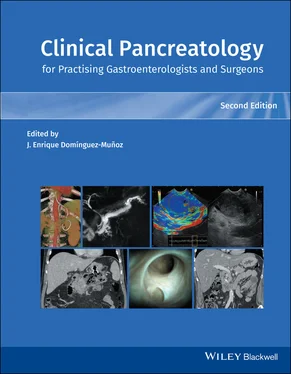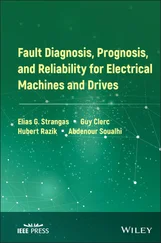Table 1.2 Indications for genetic testing in patients with acute pancreatitis.
Source : adapted from Hasan et al. [38].
| Idiopathic acute pancreatitis in patients aged <35 years Acute recurrent idiopathic pancreatitis Family history of idiopathic chronic pancreatitis or recurrent acute pancreatitis Individuals whose families have an identified gene mutation associated with hereditary pancreatitis |
Up to 22% of patients with AP, after extensive evaluation, have an unidentified cause of their AP. In these patients with so‐called idiopathic pancreatitis, we must explore all possible causes of AP as they have an increased propensity to develop recurrent pancreatitis and possibly chronic pancreatitis and pancreatic cancer. In addition, once a cause is identified, invasive diagnostic testing can be limited. Genetic abnormalities are frequently not sought in these patients. Jalaly et al. [37] evaluated 197 patients with ARIP, including 134 who underwent genetic testing, and found 88 pathogenic genetic variants in 64 (48%). Pathogenic genetic variants were identified in 58% of patients with ARIP and in 63% of patients with unexplained first episode of AP aged below 35 years. These were independently associated with pathogenic genetic variants in their adjusted analyses [37]. In addition, the authors found that a family history of pancreatitis did not predict pathogenic variants on genetic testing as these patients may have contracted AP from the usual causes.
Current smoking compared with lifelong nonsmoking is associated with AP (relative risk, RR, 2.14) after adjustment for age, sex, BMI, and alcohol consumption. This association is stronger (RR 3.19) in heavy smokers (20–30 cigarettes/day). This association was independent of alcohol consumption [40]. Barkin et al. [7] reported that cannabis use is a likely cause of AP, and that abstinence eliminates recurrent episodes.
Drug‐induced AP must be considered in all patients with idiopathic AP. We have information on very few drugs where patients have undergone positive rechallenge, even more so on drugs with consistent latency. Most of our information is from case series and reports [41]. It is estimated that up to 5% of AP is caused by drugs [42]. The drug may be a single etiology or a cofactor (i.e. acting with a gene or another drug). Unfortunately, there are no clues except history to drug‐induced AP as it is not accompanied by evidence of a drug reaction (i.e. rash, lymphadenopathy and/or eosinophilia) [42]. Table 1.3lists the drugs most likely to cause AP; however, multiple other drugs have been associated with AP [43].
Pancreatic neoplasms, both primary and metastatic, can present with AP. The relationship between an underlying pancreatic cancer and AP is well recognized [44]. This association has been found both in western and eastern populations [45]. The risk of an underlying pancreatic cancer is greatest in the first year after AP and then decreases, and such a cancer should be sought in patients aged over 40 years who have AP [44]. On imaging, the appearance of AP may obscure the small underlying pancreatic cancer, or the method itself may be insufficiently sensitive. A clue to the existence of an underlying pancreatic cancer is the presence of pancreatic duct dilation. In a systematic review, Wan et al. [15] compared EUS with MRCP in patients with idiopathic acute pancreatitis and showed that EUS had a diagnostic yield of 64% compared with 34% for MRCP. Therefore, EUS is the recommended method when screening for an underlying neoplasm in patients aged over 50 years, even if a likely cause of their AP is present (i.e. alcohol and gallstones). To quote Munigala et al. [44]: “It is usually inappropriate to assume a causative correlation between any metabolic disorder or drug with the first episode of AP.” To cast blame on alcohol or gallstones for AP in patients with an underlying pancreatic cancer results in delayed diagnosis. This is also applicable to patients who present with a pseudocyst [46].
Table 1.3 Drugs commonly associated with acute pancreatitis.
Source : adapted from Tenner [42].
| 6‐Mercaptopurine Azathioprine Valproic acid Didanosine Angiotensin‐converting enzyme inhibitors Furosemide Isoniazid Metronidazole Sulindac Tetracycline Amiodarone Lynesterol/methoxyethinylestradiol Norethindronate/mestranol Trans‐retinoic acid Interferon‐alpha |
The diagnosis of AP is based on the presence of a chief complaint of epigastric abdominal pain in an appropriate individual who has a propensity for an etiology of AP and the finding of a laboratory test greater than threefold the upper limit of normal. Early imaging on admission or in the emergency room using CT is only indicated if diagnostic criteria are not fulfilled or there are findings that call the diagnosis of AP into question. Unfortunately, upper abdominal pain and tenderness is a frequent presentation of a plethora of disease states. Abdominal tenderness from AP may, in addition to epigastric location, also be present in the right upper quadrant. Findings of an acute abdomen may be present and, if so, CT imaging should be considered. The pain may radiate into the back and be associated with nausea and vomiting as well as fever [47]. The second consideration should be whether the patient has a potential etiology for AP (e.g. biliary disease, alcohol, trauma; see Table 1.1). Its presence increases our diagnostic certainty.
The laboratory diagnosis for AP has changed from determination of amylase to determination of lipase but the criterion is still a threefold increase. Lipase has several advantages over serum amylase: sensitivity is higher (82–100% vs. 67–100% for total amylase) and a slightly better specificity (82–100% vs. 85–98% for amylase) [47]. In addition, lipase offers a larger diagnostic window than amylase as it remains elevated for a longer period: amylase elevation lasts for only three to five days [48] whereas lipase shows persistent elevation for up to two weeks. Other causes of elevated lipase in patients with abdominal pain include trauma, appendicitis, diabetic ketoacidosis, small bowel disease, inflammatory bowel disease, ischemia, obstruction, cirrhosis, renal failure, and upper gastrointestinal malignancies (esophagus, stomach). It is questionable whether HTG may produce falsely low lipase levels [27]. There is no advantage of ordering amylase together with lipase. Unfortunately, laboratory tests are not diagnostic of AP and levels do not predict severity of AP. There is no benefit in monitoring laboratory diagnostic tests (i.e. amylase/lipase) during the course of AP [48].
The initial imaging of a patient with suspected AP should include chest X‐ray and flat and upright abdominal radiographs. Their usefulness is to exclude other causes of abdominal pain, and occasionally to visualize findings suggestive of AP (i.e. sentinel loop, colon cutoff sign, and left pleural effusions) [47]. Abdominal surface ultrasound should follow radiological imaging. Its best role is for gallbladder visualization with determination of the presence of cholelithiasis. It can visualize the pancreas in approximately two‐thirds of patients, revealing peripancreatic changes of inflammation; however, this is markedly decreased when the individual is obese and or if an ileus is present.
CT is the gold standard for pancreatic imaging. However, when possible, it should not be performed until the patient has been rehydrated. This delay will prevent renal injury from contrast and allow the clinician to decide if CT is needed. The primary reason for early CT scan (<72 hours) is diagnostic uncertainty. Early CT does not improve clinical outcome or influence treatment nor does it improve prediction of severe disease over clinical scoring. Optimal timing for initial CT assessment is 72–96 hours after onset of symptoms [49], which also allows time for necrosis to occur. The advantages of CT over magnetic resonance imaging (MRI) is its increased availability and decreased cost. It has increased sensitivity for definition of small air bubbles and calcification within the pancreas [50].
Читать дальше












